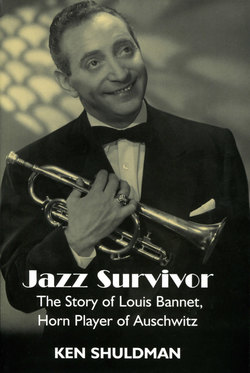Читать книгу Jazz Survivor: The Story of Louis Bannet, Horn Player of Auschwitz - Ken Shuldman - Страница 6
На сайте Литреса книга снята с продажи.
Prologue
ОглавлениеI arrived early for Louis Bannet’s memorial service that sweltering June day back in 2002. As I entered the Benjamin Funeral Home in Toronto, there were only a few people seated in the sanctuary, mostly older members of the Dutch community that once flourished in Toronto. These men and women, with their walkers and canes, had once danced to the driving rhythms of Louis Bannet and his band.
Sitting alone by the simple wooden coffin, silently reciting from the Book of Psalms, was the Shomer, the religious watchman and guardian of the spirit. I wondered, was one Shomer enough for such a spirit?
I first heard the name Louis Bannet while on a tour of the construction site of the Museum of Jewish Heritage/A Living Memorial to the Holocaust in New York City. At the time, I was working for the advertising agency that was developing a campaign for the museum. Dr David Altshuler, the museum’s esteemed first director, was pointing to where several exhibits were to be displayed. As we gingerly walked past steel girders and exposed wires, he motioned towards a corner where a glass case would stand. Inside that case, he said, would be a trumpet that belonged to a man named Louis Bannet, once known as the Dutch Louis Armstrong. The idea of a trumpet and jazz in a Holocaust Museum seemed odd and strangely out of place, and I filed the story away in my memory.
About a year after the museum opened, I was asked to create several television commercials that would feature the great actress Meryl Streep and the violin virtuoso Itzhak Perlman, who were both providing the voices for the museum’s audio tour. We decided that one commercial would feature Louis Bannet’s story, and we flew him to New York from his home in Toronto. When he arrived on the set, we knew we were in the presence of someone very special. He began performing immediately, as if the last fifty years were just a brief intermission, and, in a matter of moments, he had everyone under his spell. But soon the magic would come face to face with the tragic. We had planned to use Louis’ trumpet in the commercial, but the museum was concerned about its safety, so a production designer found an exact replica. Louis was brought to the second floor of the museum, the Holocaust floor. As you enter the room, you are greeted by a tiled wall of faces, gaunt with eyes sunk in their sockets. As Louis walked in, holding the trumpet, he met the gaze of the faces on the wall, the same people who may have heard his music as they were marched to the gas chambers. It was too much for him to bear. He fell to his knees and began to wail. Many in the crew of burly teamsters wept openly. Louis was helped up and, without missing a beat, said, ‘Let’s get to work.’ The next thing we knew, he was sitting on Meryl Streep’s lap.
During lunch he began to talk about some of his experiences before the war and in the camps. It seemed like he had one amazing story after another. It became quite clear that there was more to Louis Bannet’s life than a thirty-second commercial.
Historian and lecturer Dr Jud Newborn, who originally brought Louis’ trumpet to the museum, and accompanied him that day from his home in Toronto, characterized the day’s events this way: ‘The filming of that commercial was the fulfillment for him of his story the culmination of the whole process of personal grief, letting go, feeling it all in vain - and then finally moving into collective history and memory for real, after all those years, knowing he really had borne witness in museum form after all.’
Over the next two years, together with my partner, Dutch translator and dearest friend Jeroen Bours, I made several trips to Toronto, interviewing Louis in his small music-filled study. Entering the Bannet home was like walking into a piece of Delft pottery. Everywhere you looked, everywhere you turned, there was blue - even in the bathroom, which was stocked with blue towels, blue tissue paper and blue soap. Those visits with Louis and his beloved Flora were filled with tears and laughter, as well as ample portions of brown bread, herring and stroopwafels, the Dutch caramel cookies Louis loved so. These were some of the most special moments in my life. And after each remarkable episode, Louis would turn to Jeroen and me and say, ‘I tell you some stories, don’t I, boys?’
This book is a humble attempt to give those stories a welldeserved home.
